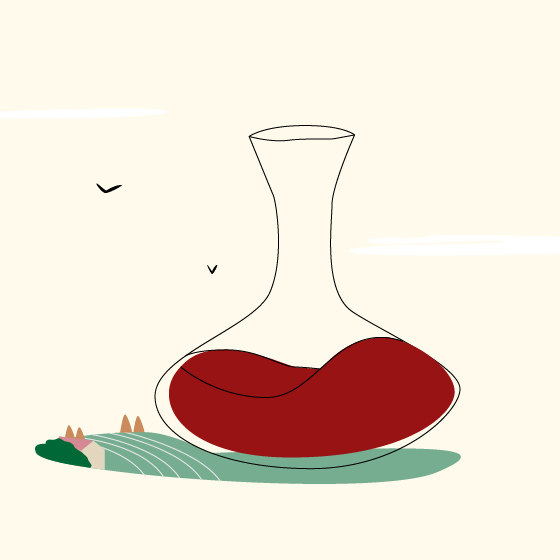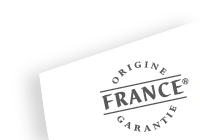Carafing and decanting wine: all you need to know for great tastings
Wine lovers often choose to pour a bottle of wine into a carafe before tasting it to make sure it gives its very best. While in some cases, it certainly can enhance a wine, it isn’t always necessary. Why carafe or decant a wine? We explain when to do it and what to use.

1. Why carafe or decant a wine?
Carafing simply means pouring a bottle of wine into a carafe. The process is carried out for two different reasons: aerating or decanting.
Aerating
This technique provides the wine with more oxygen because it puts the wine in contact with plenty of air. The idea is to encourage young wines to express their full palette of aromas. The process is like swirling a wine in a glass to give it some air and bring out its aromas and flavours. Aeration helps to ensure the taste of the wine is balanced and that the wine expresses its full character. If the wine is very young, you can even shake the carafe vigorously to further accelerate the oxygenation process.
Decanting
Over time, solid deposits can form at the bottom of older bottles. Decanting eliminates these impurities, so they don’t interfere with the tasting experience. Depending on how they have been bottled, unfiltered wines can also be decanted.
2. When should you carafe a wine?
While pouring wine into a carafe can improve it in just a few minutes, it is not always the right thing to do. It some cases it can damage the wine. Carafing old vintages (more than 10 years old) is not recommended, because air contact can cause damage. If an old wine contains sediment, it is still possible to decant it, if you wait until the last minute. This is to prevent premature oxidation.
Most wines do not need to be decanted. This is true for “everyday” wines (Vins de Pays, Bordeaux Supérieurs, etc.), which are made for quick and easy tasting. In this case, aerating the wine in the glass is more than enough.
Most often, carafing is only for young wines (less than 10 years old), sulphur-free “natural” wines, and Grand Crus. By aerating the wine, you are allowing it to release all its aromas and develop tactile sensations in the mouth. If a wine is especially woody, aerating can soften tannins with a rough edge.
This process helps to reveal all the subtle features of a wine, and is particularly beneficial for expressive wines, terroirs and grape varieties. Although it is often associated more with red wines, it can enhance white, rosé and even sparkling wines as well. Some old champagnes can also be aerated. But be careful, the process can destroy some of the bubbles.
If you have any doubts about whether to carafe a wine, the simplest thing is just to taste it! If it seems tight and expresses little aroma, aerating it will make it more pleasant to drink.
3. How to carafe a wine
Carafing is a delicate process. To allow a young wine to express itself as much as possible, it is advisable to carafe it two to three hours before tasting. Here’s what to do:
Find a suitable recipient
This is an important choice, because a carafe for aerating is specially designed with a wide bottom and a flared neck to get as much oxygen to the wine as possible. In terms of practicality, you should also make sure that your carafe is easy to handle and fits neatly where you want to store it (wine cabinet, fridge, etc). If it does not meet these criteria, another option is to use one carafe to aerate your wine and another to serve it.
- Prepare your carafe if necessary
Rinse your carafe to remove micro-impurities such as dust before you start using it. If it has an odour of any kind, you can prepare it by pouring in a small amount of wine. You should then swirl it around the sides, ensuring it covers the entire interior. When you have finished, discard the liquid and begin carafing. This process also helps to prevent “off-flavours” caused by poor storage conditions.
- Pour the wine
Ready to carafe? No need for a delicate hand here, pour the entire bottle into the carafe. Pouring the wine quickly actually helps aerate it even more. Then let it rest for at least half an hour before serving. When it has been served, there is no need to replace the stopper on the carafe.
- Prepare your carafe if necessary
4. How to decant a wine
Before you decant your wine, leave the bottle to stand upright for 24 hours. The solid particles will fall to the bottom of the bottle and accumulate there.
Unlike carafing, decanting is a delicate process that requires some care and attention. During decanting, the wine must be protected from a brutal attack by oxygen. That is why decanters are tall and narrow. You can also prepare your decanter by pouring in a little wine, swirling it around to coat the insides and then discarding the wine
There’s one word to remember when decanting an old wine: be gentle! The wine must be poured slowly and in small amounts, until the deposit begins to appear in the neck. Pour the wine near a source of soft lighting so you can see these particles appear and act quickly. Once the wine has been fully decanted, replace the stopper on the decanter.
One last tip: if the wine contains solid elements that are difficult to remove (pieces of cork, deposits, etc.), filter it with a fine sieve and a wine funnel.


